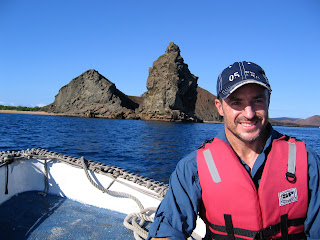Friday 30 May 2008 Part One - Bartolome Island
 A Very Special Place.
A Very Special Place. 
Behind me in the picture is the most prominent and identifiable part of Bartolome - Pinnacle Rock. Some of you may recognise it from the movie Master and Commander. This is where they filmed to scene where Russel Crowe's ship met the pirates!
It truly is a magical place and has a long history of being a refuge for 18th Century pirates. Even after coming across the islands by accident, the Spanish did not even bother to chart the islands because they were considered too hellish!
This small island located just off Sullivan Bay east of Santiago. It is a desolate island with few plants is the most visited and most photographed island in the Galapagos.
The island consists of an extinct volcano and a variety of red, orange, green, and glistening black volcanic formations. The best known of the island's features is the Tuff Cone known as Pinnacle Rock. This large black partially eroded lava formation was created when magma expelled from the volcano reached the sea. When the seawaters cooled the hot lava it caused an explosion. The exploded particles eventually fasten together forming a rock composed of thin layers. You can see many more smaller examples of this formation around the island.
As an interesting note, this prominent sight was used as a target for US airmen during WWII. When you think of all the museums and art galleries and other historical sites bombed in Europe and Great Britain during both world wars, it gives you a different perspective to think such a lonely rock thousands of miles away was affected by the same moments in human history!
Right next to Pinnacle Rock is the beach where we later snorkelled. Unfortunately the day we were there the water was a little murkey and we didn't get to see much sea life.
The island is pretty barren. It is only a small island based largely on volcanic rock so there is little vegetation.
Seasonally Bartolome is the mating and nesting site for the Green Sea Turtles. We didn't get to see any turtles, but there were fresh tracks leading to a nest (see pic below.)

Green Sea Turtles do not mate for life or form bonds with their mates. Both the males and females of the species have many partners each season. Peak mating occurs between November and January.
Females come ashore at night during high tide to lay more than 80 eggs at a time. The female may lay eggs 8 times per season. The female comes ashore and digs a pit with her flippers near the high water mark. After laying the eggs she covers them with sand before returning to the sea. The process takes 3 to 4 hours.
The temperature of the incubation determines the sex of the young turtles. Eggs incubated at 82ºF will be males and those incubated at 90ºF will become females. The eggs hatch in approximately 2 months.
Very few of the hatchlings survive their first year of life. Eggs are vulnerable to pigs and goats, as well as the natural predator the Trox Suberosus Beetle. Sea Birds prey on the young turtles making their way from their nests to the sea. Once in the water Orcas, Sharks and Crabs feed on the turtles. With the high mortality rate and disappearing nesting grounds around the world Green Sea Turtles are now an endangered species and the Galapagos breeding grounds is an important area for the preservation of these creatures. However we were lucky enough to still see one very young turtle off the stern of our boat on our last night. It was little bigger than the palm of my hand. It was an amazing sight, but I still wondered whether it would survive the night.
After this morning ride we visited the most alien place on Earth!
See the next post!!!!


0 Comments:
Post a Comment
Subscribe to Post Comments [Atom]
<< Home